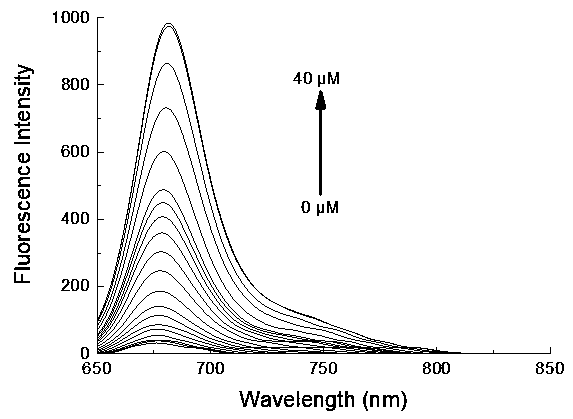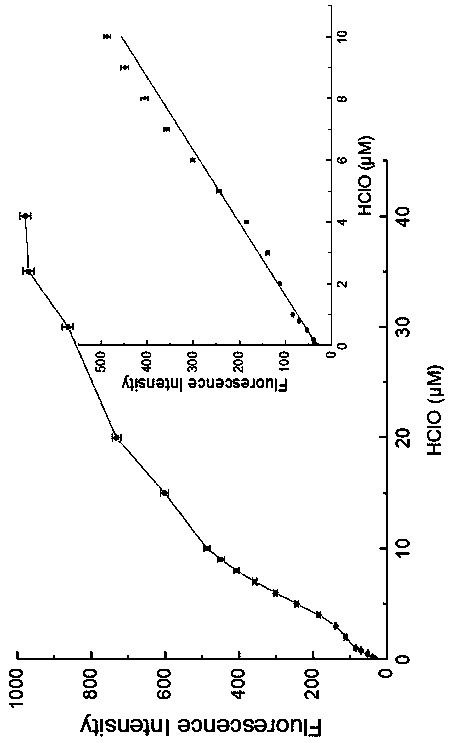Lysosome-targeted hypochlorous acid near-infrared fluorescent probe as well as preparation method and application thereof
A fluorescent probe, hypochlorous acid technology, applied in the field of analytical chemistry, to achieve high lysosome targeting ability, accurate and stable optical signal and imaging effect, and the effect of reducing background interference
- Summary
- Abstract
- Description
- Claims
- Application Information
AI Technical Summary
Problems solved by technology
Method used
Image
Examples
Embodiment 1
[0029] Synthesis of Fluorescent Probe Compound Lyso-NIR-HClO
[0030] (1) Synthesis of compound 1
[0031] Add 6 g of 3-bromo-N,N-dimethylaniline and 60 ml of anhydrous diethyl ether into a dry 250 ml round bottom flask at -78°C under the protection of argon, and stir magnetically for 5 minutes to dissolve , and then 13.1 milliliters of n-butyllithium n-hexane solution with a molar concentration of 2.4mol / L was slowly added dropwise to the reaction solution, and after the dropwise addition was completed, it was reacted at 0°C for 2 hours, and then 2.2 milliliters of dichlorodimethylsilane Dissolve in 10 ml of anhydrous ether, and then slowly add it dropwise to the above reaction solution. After the dropwise addition, react to room temperature and stir overnight, add 50 ml of water to quench the reaction, and extract the reaction solution with ether, and separate it with a separatory funnel. The organic phase was washed with water (50 ml × 2), washed with saturated NaCl aqueou...
Embodiment 2
[0043] Determination of Fluorescence Spectrum of Fluorescent Probe Compound Lyso-NIR-HClO with Different Concentrations of Hypochlorous Acid
[0044] Dissolve the fluorescent probe compound Lyso-NIR-HClO prepared in Example 1 in N,N-dimethylformamide (DMF) to make a 10 μM stock solution, take 2 ml from the stock solution and add it to a 5 ml centrifuge In the tube, add hypochlorous acid standard solutions of different equivalents (0-8), dilute to 4 ml with a solution of PBS buffer solution (10mM, pH=7.4) (DMF / PBS volume ratio is 1:1), and use 620nm as the Excitation light, the slit width is set to 5nm / 5nm, and the fluorescence spectrum is measured. Fluorescence spectra such as figure 1 As shown, with the addition of hypochlorous acid, the fluorescence at 680nm is gradually enhanced, and the relationship between the fluorescence intensity and the concentration of hypochlorous acid is as follows image 3 shown at 5.0 x 10 -8 -1.0×10 -5 There is a linear relationship within t...
Embodiment 3
[0046] Determination of UV-Vis Absorption Spectrum of Fluorescent Probe Compound Lyso-NIR-HClO with Different Concentrations of Hypochlorous Acid
[0047] figure 2 It is an ultraviolet-visible absorption spectrum diagram of the fluorescent probe compound Lyso-NIR-HClO prepared in Example 1 reacted with different concentrations of hypochlorous acid, and the amount of hypochlorous acid added is 0-40 μM. As can be seen from Figure 2, an absorption peak can be observed at 660nm, and as the concentration of hypochlorous acid increases, the absorbance at 660nm increases gradually. The instrument used for the determination of the ultraviolet-visible absorption spectrum is a TU-1900 ultraviolet-visible spectrophotometer (Beijing Purkinje General Instrument Co., Ltd.).
PUM
 Login to View More
Login to View More Abstract
Description
Claims
Application Information
 Login to View More
Login to View More - R&D
- Intellectual Property
- Life Sciences
- Materials
- Tech Scout
- Unparalleled Data Quality
- Higher Quality Content
- 60% Fewer Hallucinations
Browse by: Latest US Patents, China's latest patents, Technical Efficacy Thesaurus, Application Domain, Technology Topic, Popular Technical Reports.
© 2025 PatSnap. All rights reserved.Legal|Privacy policy|Modern Slavery Act Transparency Statement|Sitemap|About US| Contact US: help@patsnap.com



